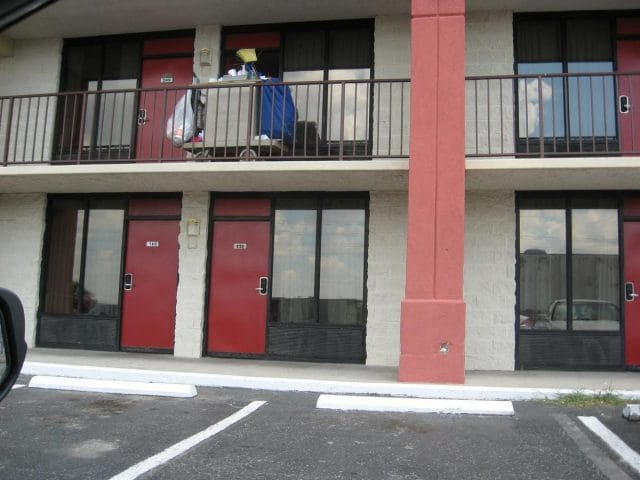
Celebrities are always on the move. Though they own multi-million dollar mansions and vacation homes, their transience places them in hotels for the vast majority of their careers. As such, many icons — especially those who struggled with substance abuse — have met their untimely demise in luxury suites, and, in some cases, dingy motel rooms.
But what happens after a famous person dies there? Does the room become a mecca for adoring fans? Does the hotel capitalize on the tragedy and charge more for the room, or remodel and try to erase history? We’ve taken a look at a few of the most publicized celebrity hotel room deaths to find the answers.
Selena: Days Inn, Corpus Christi (Room 158)

In 1995, pop star Selena was in the prime of her career. Billboard had named the 24-year-old the “top Latin artist of the 90s,” and her fourteen top-ten singles (seven of which were number one hits) had already made her one of the most successful artists of the decade.
She also had some of the most fanatic fans in history, including one Yolanda Saldívar, the president of Selena’s official fan club. When Selena caught Saldívar embezzling money and fired her, things turned sour. On March 31, 1995, Selena to meet Saldívar at a Days Inn motel in Corpus Christi, Texas to retrieve some financial records. When she arrived at the room, Saldívar instead took a pistol out of her purse and shot the recording artist in the shoulder, severing an artery. Bleeding profusely, Selena ran down the corridor before collapsing; she later died in the hospital.
Selena was heavily tributed — the town of Corpus Christi opened a museum in her honor, and then-Governor George W. Bush proclaimed her birthday “Selena Day” in all of Texas — but the Days Inn in which she died simply went on as if nothing had happened.
Following the tragedy, Days Inn closed the room for several months, replaced the carpets and bedding, and changed the room number from 158 to 150 to throw off Selena fans seeking to stay there. But some, like Selena fan Matthew Barley, were able to track it down. Barley, who stayed there in 2011, tells us that it’s indistinguishable from any other room at the motel:
“Days Inn doesn’t charge extra for the room. They will not discuss the tragedy with guests either: I personally asked them about it and the receptionist informed me they are not allowed to discuss it with guests. They try to ‘brush it under the rug,’ when people call and ask them if this is the hotel selena was shot at. I found out what room it was by doing my own research and going there prepared.”
A quick call confirms that the hotel “neither denies nor confirms” any knowledge of Selena’s death there.
Janis Joplin: Landmark Hotel, Hollywood (Room 105)

Janis Joplin, known as the “Queen of Psychedelic Soul,” rose to fame in the 1960s as the lead singer of acid-rock band Big Brother and the Holding Company. She was a major attraction at Woodstock, and Rolling Stone later pitted her as one of the 100 Greatest Artists of All Time. A journey to Hollywood in 1970 to record her album, Pearl, would be her last.
Just after midnight, Joplin returned to the Landmark Hotel, off of Hollywood Boulevard, and shot up a dose of particularly potent heroin with her bandmate. Some time later, she returned to her room (number 105), where she collapsed and died of an overdose. The 27-year-old was found wedged against the bedside table, a burnt-out cigarette in her hand.
Shortly after Joplin’s death, Meredith Montgomery, a huge fan, recalls trying to stay in the room. “The owners at the time didn’t like to talk about the whole Janis thing,” she recalls. “So, I had to sleuth around on my own to find out which room it was. Even then, they didn’t let me request a specific room.”
Sometime in the mid-80s, the hotel’s name was changed to “The Highland Gardens,” and soon after changed hands in ownership. The new owners saw an opportunity to ham up the death and make a little extra cash. Today, they not only publicize the room as Joplin’s death spot (a placard indicating this hangs by the door), but charge more to request the room (going rate for the other executive rooms is $140-160 per night; Joplin’s room, 105, can be rented for $220).
In a recent trip to Hollywood, I stayed in the room with my band, and spoke with the front desk concierge. “A whole culture emerged of people booking this room just to say they stayed where Janis died,” she told me. “I think it’s harmless.” The room’s closets are adorned with inscriptions, drawings, and love letters left by fans.
Whitney Houston: Beverly Hilton, Beverly Hills (Room 434)

Whitney Houston is one of the most celebrated singers in history, having sold over 200 million records worldwide, and charting seven consecutive number one Billboard hits. In February 2012, she attended a pre-Grammy Awards party at The Beverly Hilton in Beverly Hills, and returned to her room. Two days later, on February 11, she was found dead in her bathtub in Suite 434; a subsequent coroner’s report ruled her death an “accidental drowning,” and substantial amounts of cocaine and prescription drugs were found in her system.
In the following years, Whitney fans around the world have sought to get a glimpse of their idol’s final resting place. Earlier this year, one source at the hotel told The National Enquirer that things have gotten out of hand:
“Ever since her death, the hotel has been overwhelmed with people from all over the world hoping to book the ‘Whitney room.’ They want to see where it happened, and people have started asking specifically to stay in Room 434. Management decided it was time to move on and focus on more positive aspects of life at the hotel.”
The source claims that, initially, guests found ways to get into the room and partied with drugs and alcohol “like they think Whitney did” (some even lay naked in the tub and snapped photos). In February of 2014 — two years after the singer’s death — the Beverly Hilton closed suite 434 for an “indefinite amount of time” to give it a complete remodel. Room numbers will be changed, and the suite, along with others on the floor, will be re-named. In every respect, the hotel is attempting to respect Whitney’s passing, and discourage guests from willingly staying there.
“If management has their way,” added the source, “the next person that gets that room won’t have a clue Whitney Houston died in the bathroom.”
Jimi Hendrix: Samarkland Hotel, London (Room 507)

On September 18th 1970, famed rock guitarist Jimi Hendrix was found dead in room 507 at the Samarkland Hotel in London, England, a victim of drug abuse. He’d checked in 12 days earlier with his girlfriend, and had last been seen polishing his shoes in the fifth floor suite.
Today, the Samarkland only leases its rooms for extended stays to international bankers, and Hendrix’s death room can’t be purposefully booked. However, another local hotel, the Cumberland, claims that it was the rocker’s real last residence and takes full advantage of the tourists that pour in seeking a piece of history. While this isn’t true, Hendrix did often frequent the Cumberland for its “running hot and cold hookers” and lax drug use policy.
Today, the Cumberland is a luxury hotel, and has a “Jimi Hendrix suite” on its fifth floor, which it rents at a high markup. One guest there elaborates on the cheesiness of the suite’s decor:
“Primary colored op-art lines swirl across the ceiling; there are zebra-skin throws, fibre-optic lights, framed pages from the music papers of the period, and a huge mural of Hendrix dominates one wall. It is a fun experience, if not exactly an authentic one, lent a particular poignancy by the film of Hendrix flickering on the large plasma television screen — a little big to throw out of the window — and by a tape of Hendrix’s last-ever interview, which is available for guests to play.”
In the 60s, Hendrix used to pay £17, or about $29 USD ($187 in 2014 dollars) per night to stay there; today, the suite runs £399 ($683 USD) per night.
Oscar Wilde: L’Hôtel, Paris (Room 16)

How about stars of bygone eras? Does the passage of a lot of time make it okay to profiteer off of a public figure’s death? In the case of Oscar Wilde, Paris, France’s L’Hôtel thinks so.
Wilde, an Irish playwright and poet known for The Picture of Dorian Gray and The Importance of Being Earnest, rose to prominence as one of London’s premier writers in the late 1800s. But by the turn of the century, Wilde found himself embroiled in a series of legal battles over his “gross indecency with other men,” and was sentenced to two years of hard labor in prison; upon his release in 1900, he fled to France, where he died in destitution and poverty at the age of 46.
His final resting place was the Hôtel d’Alsace (now known as L’Hôtel), a dingy establishment in Paris. On his deathbed, he wrote, “this poverty really breaks one’s heart: it is so sale, so utterly depressing, so hopeless.” Since Wilde’s death, the hotel has become a major tourist attraction; today, it is a four-star resort with rooms going for as much as $700 USD per night. Rock and film star patrons vie to stay in room 16, where Wilde said his last words.
Today, the room has been decked out in Wilde fanfare, and guests pay high premiums to stay there. One reviewer writes of his experience staying there:
“We’re in room 16 at the gorgeous fin de siècle boutique hotel L’Hôtel in Paris, and the wall in front of us is a bit, well, shrine-like. Faded sepia photos of Oscar Wilde jostle for space alongside framed newspaper clippings and 19th-century cartoons of the great man, and a slightly eerie figurine grins at us malevolently from the top of the writing desk. If this were in any other room in Paris, then it would undoubtedly be a bit much. But we are in the room where Oscar breathed his last. I am ecstatic to be spending the night in his deathbed.”
The hotel is no longer the shithole Wilde described it as. “The lobby, with its leopard-print carpet, antique screens and original Jean Cocteau artwork, exudes fin de siècle glamour,” continues the reviewer, “and our room is just as decadent.”
***
Of course, this list is only partial: dozens have met their end at hotels (The Ultimate Warrior, John Belushi, Sid Vicious, James Gandolfini, Anna Nicole Smith, Coco Chanel, Nikola Tesla — the list is enormous, and too long to list in its entirety). In some cases, the room is simply inaccessible to most of the public (the suite Ritz Hotel room Coco Chanel died in in Paris runs $12,000 per night, for example). In other instances, like that of John Belushi’s death, the hotel was completely remodeled to avoid becoming a cult symbol.
Peter Greenberg, Travel Editor for CBS News, tells CNN that most hotels have a systemized plan of action in place in the event that a celebrity dies. First, he says, the hotel calls the police (“They [don’t touch] the room so they preserve the evidence for the investigation”). After the police investigation, it’s up to the hotel’s discretion whether or not to rent the room back out to regular guests. For the most part, hotels choose to keep rooms in operation, sometimes discreetly, and other times publicly, at a mark-up.
Jacob Tomsky, an ex-hotel manager, says that in most cases requests for a “celebrity death room” are denied: “We are trained early on to have this phrase at the ready, no matter how old and tired it may sound: ‘I can neither confirm nor deny that information. I’m sorry.’ But….you’d be amazed at how fast they turn over a room that’s had a tragedy occur inside of it.”
This post was written by Zachary Crockett. Follow him on Twitter here, or Google Plus here.



